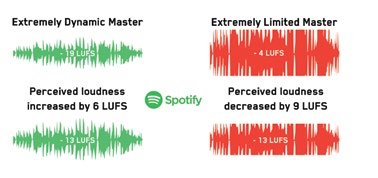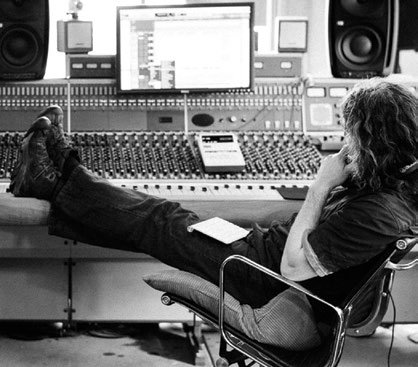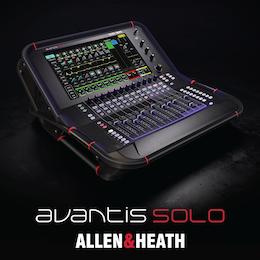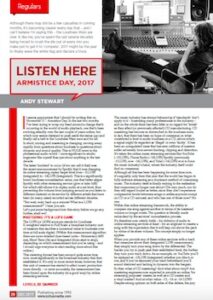Subscribe to CX E-News
Regulars – Listen Here
Armistice Day, 2017
By Andy Stewart.
Although there may still be a few casualties in coming months, it’s becoming clearer every day that – and I can’t believe I’m saying this – the Loudness Wars are over. If, like me, you’ve spent the last several decades being forced to crush the life out of every mix you make just to get it to ‘compete’, 2017 might be the year to finally wave the white flag and declare a truce.
It seems appropriate that I should be writing this on November 11 – Armistice Day. In the last two months I’ve been trying to wrap my head around a change that’s occurring in the world of audio playback, one that’s been evolving steadily over the last couple of years online, but which now seems destined to push aside the status quo and finally call a halt to the Loudness Wars once and for all.
In short, mixing and mastering is changing; moving away rapidly from questions about loudness to questions about dynamic and sound quality. This is HUGE news in the professional audio world – more significant to studio engineers like myself than just about anything in the last decade.
The latest ‘incident’ to occur (if we can call it that) was the recent announcement by Spotify that it was changing its online streaming replay target level from –11LUFS (integrated) to –14LUFS (integrated). This is a significantly lower loudness normalisation value, one that better aligns Spotify with other streaming service (give or take 3dB) but which still allows it to replay audio at a set level, thus preventing the volume from jumping around as you listen to different material on its service by different artists that have been (in many cases) recorded across different decades.
“But wait, wait, back up a minute! What is a LUFS measurement?” I hear you ask. Let’s put some background into this story before we go any further, shall we?
MASTERING: IT’S A LUFS GAME
The LUFS (or LKFS) acronym stands for Loudness K-weighted relative to Full Scale: a broadcast industry unit of measure that ascribes a numerical value to loudness over time at full scale digital. (Within this measurement algorithm there are more detailed time-based units – Momentary (400 ms), Short Term (3s) and Integrated (from start to stop), depending on which measurement tool you’re using – and I would urge everyone to start reading more about this online.)
This metering format has been around quite some time now, most significantly in the broadcast industry that first established it. It’s only in more recent times, however, that this unit of measure has started to affect music production more directly – or more accurately, the measurement has been forced upon the industry (in a good way) by online streaming services.
LEVELS, BE DAMNED!
The music industry has always behaved as if ‘standards’ don’t apply to it – frustrating many professionals in the industry – and on the whole there has been little or no regard for ‘levels’ as they affect (or previously affected) CD manufacturing.
CD mastering has become so entrenched in the loudness wars, in fact, that there has been no hope of consensus on what constituted a limit to audio loudness on a CD, above which a signal might be regarded as ‘illegal’ or even ‘faulty’. It has been an unregulated mess that has seen millions of masters suffer adversely from severe limiting, clipping and distortion. It’s taken the online music streaming services like YouTube (–13LUFS), iTunes Radio (–16LUFS) Spotify (previously –11LUFS, now –14LUFS), and Tidal (–14LUFS) et al to force the music industry’s hand, where the industry itself could find no consensus.
Although all this has been happening for some time now, it’s arguably only been this year that the world has begun to fully embrace streaming as a dominant method of consuming music.
The industry itself is finally waking to the realisation that consumers no longer care about CDs very much, nor do they still regard louder as better, since they don’t experience comparative levels betweens songs or artists anymore except on CD or a CD carousel, and who has one of those now? No-one.
Within this online streaming framework, the ability to compare one song against another in terms of its mastered volume no longer exists. The question is literally made redundant by the services’ normalisation process.
It’s therefore now utterly futile – for delivery of audio to online streaming services at least – for an engineer to master a song with the expectation that it will leap out above the pack by virtue of its sheer volume. The concept simply no longer applies.
When you provide any of these online services with a track that measures above their designated LUFS measurement, they simply turn your song down by the differential. The harder you try to push past their established level, the further they turn your track down. As an example, on YouTube you’ll be replayed at –13LUFS (integrated) whether you like it or not, and if you’ve slammed your track beforehand you’ll sound distorted and lacking in dynamic into the bargain.
So then what of CD mastering? And what about vinyl? Are mastering engineers now expected to provide an online ‘for streaming purposes’ master, as well as a CD master anda vinyl master? And at what value: –13, –14 or –16 LUFS?
Despite strong opinion on both sides of this debate, the jury is well and truly out on whether several masters are required to be produced for every album that’s released.
I’d contend (this week at least) that the new LUFS measurements established by the online broadcasters are, though not directly affecting CD levels, making all but redundant the war that’s waged on that 16-bit format.
This is not to say that everyone agrees – some CD masters out there are still measuring at insane levels of around –6LUFS integrated, and that’s why adhering to a LUFS measurement is still regarded as ‘optional’ in certain circles and by certain mastering engineers. While this remains the case we’re going to see fluctuating levels across CDs in particular. But pretty soon I suspect CD releases with a LUFS measurement in the single figures are going to sound dated to the ears of listeners as they grow accustomed to the sound of more dynamic, less distorted online streaming services.
In the same way as flat-screen TVs relegated cathode ray tubes to the scrap heap, online streaming must surely either relegate CDs to the junk pile (which I would regard as a shame) or finally provide CD mastering with an ‘out’ that finally allows CD mastering houses to back off their limiters once and for all!
THE FUTURE IS NOW
Last week I produced a CD master here at The Mill that was caught up in this mess. It was too loud and distorted for the client’s liking, and for mine too quite frankly, but compared with so many other CDs out there it was still only barely cutting it in the loudness wars. So I finally thought: “well, this is it. The time has come to apply the –14LUFS integrated (or thereabouts) measurement to the CD format. No more games… I’m looking forward, not back.”
I produced a master at –13.8 LUFS (integrated) with a true peak level of –0.5dBFS. That is quiet by most CD standards today, but the client loved the outcome and never once questioned the CD’s inherent level.

Are the Loudness Wars over? They are for me. I’m looking to the future now, into a listening world where consumers appreciate dynamic range.
Low distortion, dynamic music will be audio’s 4k TV equivalent, and excessive distortion artefacts and slammed masters will be the low-res TVs of yore. From now on I’ll be assessing the dynamic of albums I produce, mix or master on a per-album basis. I will only do what’s best for the sound of each, and I will no longer wage war on the wider industry.
Coincidentally, –14LUFS integrated is right around where a lot of my mixes end up before they’re mastered… so now I’ll barely have to touch them before they’re released into the world.
Andy Stewart owns and operates The Mill in the hills of Bass Coast in Victoria. He’s happy to respond to any pleas for recording or mixing help… contact him at: andy@themillstudio.com.au
This article first appeared in the print edition of CX Magazine December 2017, pp.28-29. CX Magazine is Australia and New Zealand’s only publication dedicated to entertainment technology news and issues. Read all editions for free or search our archive www.cxnetwork.com.au
Subscribe
Published monthly since 1991, our famous AV industry magazine is free for download or pay for print. Subscribers also receive CX News, our free weekly email with the latest industry news and jobs.













